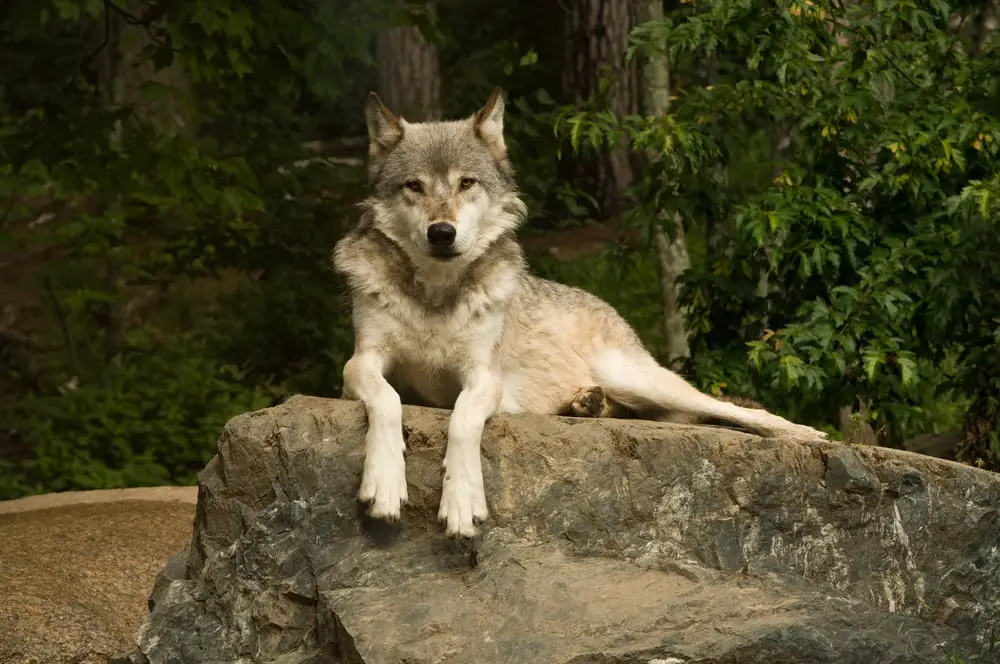The Great Plains wolf, also known as the buffalo wolf and Canis lupus nubilus, is the most common subspecies of Gray Wolf in the contention United States. In the past, the Great Plains wolf had the most extensive range of any wolf breed inhabiting the U.S.
Hunted to near extinction in the 1930’s, the Great Plains wolf is found today in parts of Minnesota, Wisconsin, Michigan, and Ontario (the Great Lakes region).
Two states, however, North and South Dakota have detected lone Great Plains wolves, but these wolves were thought to be dispersers from populations outside the Dakotas, and that no actual breeding population of Great Plains wolf exists there.

Identifying characteristics of the Great Plains wolf.
Great Plains wolves can be as long as 6 1/2 feet from nose to end of tail, and weigh up to as much as 120 pounds. The male Great Plains wolf weighs about 20% more than the female Great Plains wolf. Both sexes of the Great Plains wolf have coats colored a blend of brown, grey, black, red, or light brownish yellow.
Great Plains wolf diet.
The diet of the Great Plains wolf consists of white tailed deer and moose whenever possible, with smaller mammals like hares, rodents, and birds filling in in times of scarcity. Deer and moose are often taken by packs averaging up to 6 Great Plains wolves at a time, that stampede and cull the weak and the young from the herd.
Smaller mammals like snowshoe hare, and smaller birds and mammals fill in during times of scarcity.
Great Plains wolves today.
After some studies showed that Great Plains wolves resided in sufficient numbers in Minnesota, Wisconsin, and Upper Michigan, they were reclassified from an endangered speicies to a a threatened species in in 1978.
By 2010, some 3,000 Great Plains wolves were deemed insufficient and the subject of a lawsuit between the Fish and Wildlife Services and some environmental groups caused the Great Plains wolf to be re-added to the endangered species list.
For the record, the Fish and Wildlife Service believes Great Plains wolves have recovered and do not need to be included on this list.
Great Plains wolf lifecycle.
Like coyotes and other wolves, the Great Plains wolf mates for life, and only the non-related alpha female and the alpha male will produce offspring. Great Plains wolf pups are born from January through late February at such northern climates. After a 63 days of gestation, the mother gives birth to 4 to 6 pups in a den. Theses Great Plains wolf pups become fully grown in 6 to 8 months and are sexually mature by about 22 months—much like all wolves.
Great Plains wolf Behavior and Communication
Unlike coyotes, great plains wolves sometimes hunt in packs with other unrelated (genetically) wolves. Within a family unit, wolves work together to protect their territory, raise their young, and hunt larger prey. They communicate with each other by howling, barking (usually only by juveniles), whimpering, and snarling.
Wolves also communicate with each other using body language; even humans can easily translate it. For example, a subordinate gray wolf approaches a dominant pack member by tucking its tail between its legs, pinning its ears back, and slinking toward it—ready to submit.
Friendly social equals and mates approach each other with raised heads, tails, and ears. Conversely, disputes between equals, non-pack members, and other threats are greeted with growls and displayed fangs.
A Great Plains wolf howls are longer than coyote howls and noticeably smoother and more profound in their tone. The information being communicated in these howls, however, is the same for each animal. For example, who is calling, where they are, and the sender’s mood (threatened or unthreatened).

